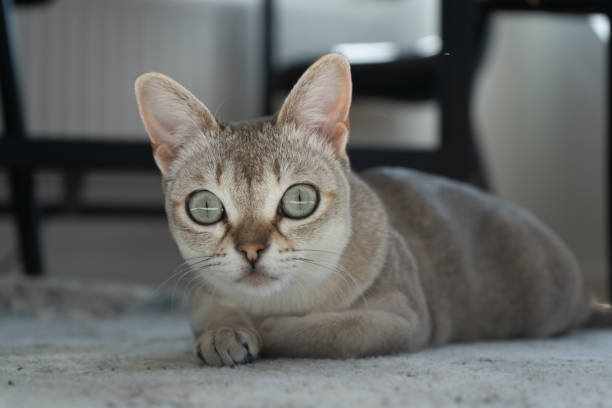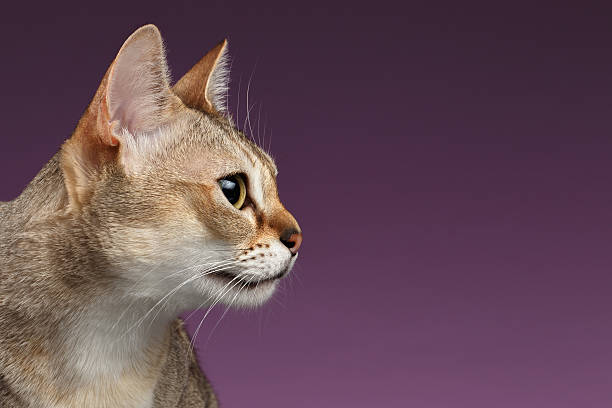Singapura Cat

History:
The Singapura Cat is one of the smallest domestic cat breeds and is known for its distinctive sepia-toned coat and large, expressive eyes. Its origins trace back to Singapore, where cats with similar appearances were found in the streets and docks. In the 1970s, American breeders imported these cats and selectively bred them to preserve their unique look and charming personality. While some debate remains about whether it was developed in Singapore or the U.S., the breed is officially recognised as a natural breed. The Singapura is celebrated for its affectionate nature, intelligence, and playful spirit. Despite its petite size, it has a lively and curious disposition, often shadowing its humans with kitten-like energy.
Size: Small-sized cat
Height: 15–20 cm
Weight: 2–4 kg
Life Expectancy: 12 to 15 years

Breed Appearance:
The Singapura is a small yet muscular cat with a compact, well-balanced build and surprisingly strong physique for its size. Its coat is short, fine, and close-lying, with a warm beige or ivory base and sepia-toned ticking that gives it a distinctive “agouti” look. The breed’s most notable features are its large, almond-shaped eyes—typically hazel, green, or yellow—and oversized, slightly pointed ears set wide apart. The head is rounded with a short, broad muzzle and a gentle nose stop. The tail is slender and of medium length, tapering to a fine tip. Despite their dainty stature, Singapuras are agile, quick, and capable of impressive feats of climbing and jumping.
Health & Care:
The Singapura is generally a healthy breed, though it can be predisposed to some hereditary conditions, such as pyruvate kinase deficiency (a blood disorder) and uterine inertia in breeding females. Responsible breeding and regular veterinary checkups are important for long-term health. Their short coat requires minimal grooming—weekly brushing usually suffices to remove loose hair and keep the coat sleek. A balanced diet, regular exercise, and dental care contribute to their overall well-being. Because they are active and affectionate cats, consistent interaction and playtime are essential to keep them mentally and emotionally stimulated.

Living Conditions:
Singapuras adapt well to various living environments, including apartments and larger homes, as long as they receive adequate attention and stimulation. They are highly social and do best in households where someone is around often to engage with them. These cats are good with children and get along with other friendly pets, especially when introduced properly. They enjoy high perches, sunny windows, and cozy laps, often seeking closeness with their human companions. Quiet but playful, they fit well into both active and calmer homes. Creating a stimulating, affectionate environment helps them flourish and show their bright, cheerful personalities.
Grooming:
Singapuras have short, fine coats that are low-shedding and easy to care for. Weekly brushing helps remove any loose hair and keeps their coat glossy. Their grooming needs are minimal, but regular maintenance such as nail trimming, ear cleaning, and dental care should be part of their routine. Because their coat does not mat or tangle easily, they rarely need baths unless particularly dirty. Their cleanliness and low-maintenance grooming make them a good choice for owners looking for an easy-to-care-for breed. Starting grooming routines early helps ensure a stress-free experience for both cat and owner.

Advantages:
-
Singapuras are affectionate, social, and people-oriented cats that form strong bonds with their families and enjoy being part of daily life.
-
Their small size and low-maintenance coat make them ideal for apartments and busy households, requiring minimal grooming effort.
-
They are intelligent, playful, and curious, enjoying interactive toys, gentle games, and puzzle-based enrichment that keeps them mentally stimulated.
-
Adaptable and gentle, they typically get along well with children and other pets, making them great for families and multi-pet environments.
-
Despite their high energy, they are not overly vocal, offering quiet companionship and sweet interactions rather than disruptive noise.
Disadvantages:
-
Their strong need for companionship means they may experience separation anxiety or boredom if left alone for long periods.
-
Though generally healthy, the breed may inherit some genetic conditions such as pyruvate kinase deficiency, requiring awareness and health screening.
-
Their high activity level and love of exploration mean they need space to climb and play, which may be challenging in unstimulating environments.
-
Due to their small size, they may be more vulnerable to rough handling or injury, especially in households with young, unsupervised children.
-
They may become overly attached or clingy, often shadowing their humans, which may not appeal to those seeking more independent pets.

